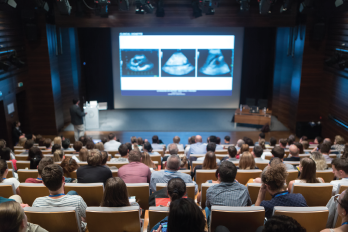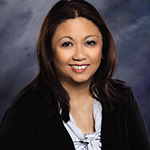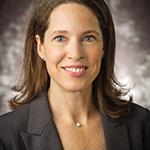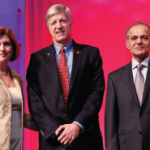
Matej Kastelic / shutterstock.com
ATLANTA—Point-of-care ultrasound education mainly has occurred at the undergraduate level at U.S. medical schools, but rheumatology fellowship training programs are rapidly catching up and integrating it into their curricula, according to two program directors who reviewed the state of rheumatology ultrasound education, including potential barriers to its implementation, on Nov. 12 at the 2019 ACR/ARP Annual Meeting.
From Scarce to Common
Ten years ago, ultrasound training was scarce in rheumatology education, said Karina Torralba, MD, MACM, RhMSUS, rheumatology chief and fellowship program director, Loma Linda University Medical Center, California. Medical students at her institution had little exposure to ultrasound. In 2013, she and her colleague, Vi A. Dinh, MD, an emergency medicine program director, talked about how to integrate ultrasound training into their curricula.
“We agreed that there needed to be a larger volume of faculty involved in this process,” said Dr. Torralba, a member of the ACR Committee on Rheumatology Training and Workforce Issues. “At the time, neurological and musculoskeletal examination via ultrasound was still optional in our programs, but this has slowly evolved.” They now offer yearly instruction in musculoskeletal ultrasound anatomy with both rheumatology and physical medicine and rehabilitation (PM&R) faculty.
Learners benefit from formal ultrasound training, she said, citing a 2015 study that showed first-year medical students improved their physical examination skills, measured by Objective Structured Clinical Examination (OSCE) scores, after they completed ultrasound training.1

Dr. Torralba
The majority of medical school deans agree that ultrasound training should be included in curricula, said Dr. Torralba. According to a 2014 survey of 82 administrators, 62.2% of U.S. medical schools had already integrated point-of-care ultrasound in their training but varied on how to implement it.2 Some programs focused more on anatomy and others on practical physical examination skills training, she said.
Core Clinical Milestones Vary
A 2016 consensus study identified 90 core clinical milestones in ultrasound training that students must obtain before graduation from medical school, according to 34 administrators.3 According to this survey, most medical school-level programs focused on building proficiency in skin, muscle, bond, nerve and tendon ultrasound.
“When we look at musculoskeletal pathology, program directors had a high consensus for looking at foreign bodies and abscesses vs. looking at joint effusions. When it came to ultrasound-guided procedures, their focus was not as much on bone abnormalities and more on emergent conditions. Also, at that time, they had no agreement on arthrocentesis as an ultrasound-guided procedure milestone,” Dr. Torralba said.
When surveyed, medical school directors have cited barriers to ultrasound training, such as lack of funding for equipment and faculty, and lack of time in their current curricula.4 One creative approach is gamification, such as a nationwide skills competition held in 2018 that included students from 34 U.S. medical schools.5 “Students were asked to identify the problem with each case. It was one way to make ultrasound education fun for the learners,” said Dr. Torralba.
Internal medicine residency programs still need to catch up to undergraduate programs when it comes to integrating ultrasound training into their curricula, she said. In 2019, the Alliance for Academic Internal Medicine issued a position statement to support integration of ultrasound across the longitudinal training environment of undergraduate, graduate and continuing medical education for internal medicine.6
In addition to lack of resources for equipment and trained faculty, “there is also no standardized curriculum for our internal medicine residents, and there is a lack of crucial image archival systems and quality assurance,” said Dr. Torralba. Residents do not currently have to exhibit proficiency in a set number of ultrasound procedures to be certified by the Accreditation Council for Graduate Medical Education (ACGME).
Rheumatology Programs
What is the state of musculoskeletal ultrasound training in U.S. rheumatology fellowship programs? According to a 2017 survey Dr. Torralba and her colleagues conducted of 108 rheumatology program directors, 94% had integrated musculoskeletal ultrasound and 41% had a formal ultrasound curriculum.7 While 95% of the respondents favored adoption of formal curricula, 65% said this step could be optional, which was a result of respondents not knowing that the majority of programs have already included ultrasound into their fellowship teaching, she said.
‘Maximize ultrasound training by incorporating & integrating opportunities into your clinical, educational & research programs.’ —Dr. Cannella
If junior rheumatology faculty face resistance from their institutions to integrate musculoskeletal ultrasound in their fellowship programs because other departments already offer this training, they must speak up and advocate for its inclusion, said Dr. Torralba. Eventually, these skills will enhance patient care, and rheumatologists certified in ultrasound should be paid accordingly, she said.
“This makes me really emotional. The ACR has a position statement on musculoskeletal ultrasound from August 2018. It says, ‘Rheumatologists who obtain training and certification in ultrasound should receive fair, timely and reasonable reimbursement for their musculoskeletal ultrasound services.’ Remember that! If you’ve been trained and you’ve been certified, you should be able to bill for your services,” Dr. Torralba said. The rheumatology community should define its own common procedural terminology (CPT) codes for musculoskeletal ultrasound scans that accurately reflect current approaches, because most codes are defined by radiologists.8
New ACGME Requirements

Dr. Cannella
In July 2019, ACGME installed new program requirements for rheumatology graduate medical education, but ultrasound training is mentioned only once in the 54-page document and is not a milestone for rheumatology education requirements, said Amy C. Cannella, MD, MS, RhMSUS, associate professor of internal medicine and fellowship program director, Division of Rheumatology, University of Nebraska Medical Center, Omaha.9 In the 2015 ACR-endorsed core curriculum for rheumatology fellowship programs, ultrasonography is mentioned 13 times, but the curriculum does not require instruction of rheumatologic ultrasound, she said. Dr. Cannella, three additional program directors and one pediatric rheumatologist partnered with academic and private practice rheumatologists to create a mini-curriculum for ultrasound education that may be integrated into the ACR core curriculum. It was published in 2019 and is available on the ACR’s website.
“Just as you do with the core curriculum, use this blueprint to design your curriculum based on your individual program’s strengths and resources,” said Dr. Cannella. The mini-curriculum includes worksheets to help program directors track instruction milestones. Tools in the rheumatology mini-curriculum include ultrasound training experiences fellows may complete, suggested educational activities and methods of assessment. For experience in simulation, fellows may practice scanning on anatomical models, cadavers or live models, for example. She strongly suggested that program directors verify fellows’ progress with both formative and summative assessments.
Verify & Assess Often
“Verify that your program is doing what you’re supposed to be doing. This can make your curriculum robust and check all the boxes for your ACGME site visit, at least with the core curriculum,” she said. The ACR mini-curriculum was developed with the same format and appendixes as the core curriculum, but also includes a pediatric rheumatology supplement with reading list, documentation templates and standard joint scanning protocols with specific targets, pictures of probe placement and goals for each technique. Dr. Cannella placed a laminated copy of her scanning guide on her clinic’s ultrasound equipment. “I tell my fellows to use the guide as a way to show your patients what you’re looking at, but also as a double check for yourself.”
Dr. Cannella teaches ultrasound didactics once a week to rheumatology and physiatry fellows, and her fellows spend time in four half-day ultrasound clinics. In 2006, only one optional half-day clinic was offered for this hands-on learning. Of her last 13 fellows, 11 now practice ultrasound, six are RhMSUS certified and two are pending certification.
“There used to be only me, and I was learning with my fellows. Now, there are four faculty ultrasonographers. At first, we did not perform any fellow competency assessments, and I was flying by the seat of my pants. Now, we have robust didactics and assessments,” said Dr. Cannella. “Maximize ultrasound training by incorporating and integrating opportunities into your clinical, educational and research programs. Ultrasound is not the salt on the french fries—it should just be the french fries. If you want to do this and do it well, you have to incorporate it.”
Fellows lead their own weekly ultrasound didactics, which are also attended by the ultrasound faculty. “I love having fellows teach each other because we all know you have to understand something in order to teach it,” Dr. Cannella said. “Fellows are assigned to write formative quizzes over the weekly topics. We all take the quiz, and then the assigned fellow walks us through the answers with rationales. You, as their teachers, don’t have to do everything. This is their program, and they can take ownership of their education. Your fellows can be great stewards and ambassadors of ultrasound.”
Fellows should take 12 months to become proficient in basic rheumatologic ultrasound, said Dr. Cannella. “It took me 19 years to get here, and there are still places where my program can improve. You won’t write your curriculum overnight, and I have been incredibly lucky to have the required top-down divisional support.”
Susan Bernstein is a freelance journalist based in Atlanta.
References
- Dinh VA, Dukes WS, Prigge J, et al. Ultrasound integration in undergraduate medical education: Comparison of ultrasound proficiency between trained and untrained medical students. J Ultrasound Med. 2015 Oct;34(10):1819–1824.
- Bahner DP, Goldman E, Way D, et al. The state of ultrasound education in U.S. medical schools: Results of a national survey. Acad Med. 2014 Dec;89(12):1681–1686.
- Dinh VA, Lakoff D, Hess J, et al. Medical student core clinical ultrasound milestones: A consensus among directors in the United States. J Ultrasound Med. 2016 Feb;35(2):421–434.
- Dinh Va, Fu JY, Lu S, et al. Integration of ultrasound in medical education at United States medical schools: A national survey of directors’ experiences. J Ultrasound Med. 2016 Feb;35(2):413–419.
- Boulger C, Liu RB, De Portu G, et al. A national point-of-care ultrasound competition for medical students. J Ultrasound Med. 2019 Jan;38(1):253–258.
- LoPresti CM, Jensen TP, Dversdal RK, et al. Point-of-care ultrasound for internal medicine residency training: A position statement from the Alliance of Academic Internal Medicine. Am J Med. 2019 Nov;132(11):1356–1360.
- Torralba KD, Cannella AC, Kissin EY, et al. Musculoskeletal ultrasound instruction in adult rheumatology fellowship programs. Arthritis Care Res. 2017 Aug 4. doi:10.1002/acr.23336. [Epub ahead of print]
- Torralba KD, Choi KS, Salto LM, et al. Musculoskeletal ultrasound scanning protocol consensus statements on scanning conventions and documentation in the U.S. Arthritis Care Res. 2019 Jun 14. doi:10.1002/acr.24005. [Epub ahead of print]
- ACGME program requirements for graduate medical education in rheumatology (subspecialty of internal medicine). 2019 Jul 1.



